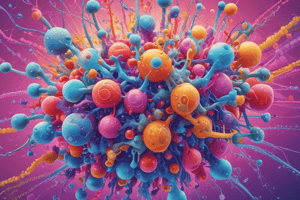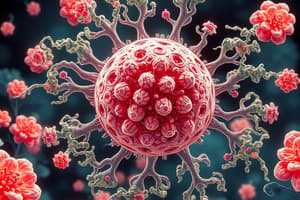Podcast
Questions and Answers
What defines an antigen in the context of the immune system?
What defines an antigen in the context of the immune system?
- A protein that is exclusively recognized by T-cells
- A molecule that can induce any form of immune response
- Any molecule that can be processed into peptides
- A molecule that can interact specifically with immunoglobulin or T-cell receptor complexed with MHC (correct)
Which statement best describes the relationship between immunogens and antigens?
Which statement best describes the relationship between immunogens and antigens?
- Antigens can never be immunogens if they are recognized by macrophages.
- Immunogens are stronger than antigens and always induce a response.
- All immunogens are antigens, but not all antigens are immunogens. (correct)
- Immunogens are a type of antigen found only in bacteria.
Which type of immunogen demonstrates the highest immunogenicity?
Which type of immunogen demonstrates the highest immunogenicity?
- Polysaccharides
- Proteins (correct)
- Nucleic Acids
- Lipids
What property of an immunogen refers to its recognition as non-self by the immune system?
What property of an immunogen refers to its recognition as non-self by the immune system?
Which of the following immunogenicity factors primarily influences the ability of a molecule to induce an immune response?
Which of the following immunogenicity factors primarily influences the ability of a molecule to induce an immune response?
What was the primary method used by the Chinese in the 12th century to immunize against smallpox?
What was the primary method used by the Chinese in the 12th century to immunize against smallpox?
Which scientist is known for developing the first rabies vaccine?
Which scientist is known for developing the first rabies vaccine?
What is a key goal of science communication?
What is a key goal of science communication?
Which of the following statements reflects a principle of integrity in science communication?
Which of the following statements reflects a principle of integrity in science communication?
What was one of the significant contributions of Edward Jenner in vaccine development?
What was one of the significant contributions of Edward Jenner in vaccine development?
What was a method used by the Turks for smallpox inoculation?
What was a method used by the Turks for smallpox inoculation?
What is an essential consideration when disseminating scientific findings to the public?
What is an essential consideration when disseminating scientific findings to the public?
What significant aspect of society influences how people make daily decisions regarding information?
What significant aspect of society influences how people make daily decisions regarding information?
What is a significant advantage of certain vaccines mentioned?
What is a significant advantage of certain vaccines mentioned?
Which method is NOT used for preparing subunit vaccines?
Which method is NOT used for preparing subunit vaccines?
What is a major characteristic of toxoid vaccines?
What is a major characteristic of toxoid vaccines?
What is a challenge associated with subunit vaccines?
What is a challenge associated with subunit vaccines?
What is the primary role of the Recombinational Signal Sequences (RSS)?
What is the primary role of the Recombinational Signal Sequences (RSS)?
What is one feature of engineered vaccines?
What is one feature of engineered vaccines?
Which type of vaccine is best suited to elicit a strong CTL response?
Which type of vaccine is best suited to elicit a strong CTL response?
What does the 12/23 rule refer to in chromosome rearrangement?
What does the 12/23 rule refer to in chromosome rearrangement?
What is the result of allelic exclusion in B-cell development?
What is the result of allelic exclusion in B-cell development?
Why might subunit vaccines struggle with pathogens that are antigenically diverse?
Why might subunit vaccines struggle with pathogens that are antigenically diverse?
What is an example of a method to prepare subunit vaccines?
What is an example of a method to prepare subunit vaccines?
What usually initiates the inhibition of further allele rearrangement in B-cells?
What usually initiates the inhibition of further allele rearrangement in B-cells?
What is the significance of constant regions in antibodies?
What is the significance of constant regions in antibodies?
Which immunoglobulin is typically produced first by a B-cell?
Which immunoglobulin is typically produced first by a B-cell?
What mechanism allows an antibody to switch its isotype from IgM to IgG?
What mechanism allows an antibody to switch its isotype from IgM to IgG?
What often prevents patients from producing different isotypes of antibodies?
What often prevents patients from producing different isotypes of antibodies?
Which part of the antibody structure is modified without affecting VDJ segments?
Which part of the antibody structure is modified without affecting VDJ segments?
What is the role of switch regions in antibody class switching?
What is the role of switch regions in antibody class switching?
What role does IL-1 play in the activation of T-helper cells?
What role does IL-1 play in the activation of T-helper cells?
Which of the following describes the function of adjuvants like alum and Freund's complete?
Which of the following describes the function of adjuvants like alum and Freund's complete?
What is an epitope?
What is an epitope?
Which statement regarding B-cell epitopes is correct?
Which statement regarding B-cell epitopes is correct?
Which characteristic is true about T-cell epitopes?
Which characteristic is true about T-cell epitopes?
What defines the affinity of an antibody for an antigen?
What defines the affinity of an antibody for an antigen?
What is the difference between avidity and affinity?
What is the difference between avidity and affinity?
Which type of bond is NOT involved in antigen-antibody interactions?
Which type of bond is NOT involved in antigen-antibody interactions?
What is the role of costimulatory signals in T-cell activation?
What is the role of costimulatory signals in T-cell activation?
What types of antigens can B-cells recognize?
What types of antigens can B-cells recognize?
What impacts the immunodominance of T-cell epitopes?
What impacts the immunodominance of T-cell epitopes?
What is the significance of the hydrophobic and hydrophilic regions of T-cell epitopes?
What is the significance of the hydrophobic and hydrophilic regions of T-cell epitopes?
What happens when T-helper cells are stimulated by antigens without a second costimulatory signal?
What happens when T-helper cells are stimulated by antigens without a second costimulatory signal?
What is the principal difference between how B-cells and T-cells recognize antigens?
What is the principal difference between how B-cells and T-cells recognize antigens?
Flashcards are hidden until you start studying
Study Notes
Antigens
- The immune system identifies foreign and self molecules as good or bad based on context.
- Antigens specifically interact with immunoglobulins (Ig) receptors on B-cells or T-cell receptors complexed with MHC.
- Immunogens are a subset of antigens that induce a specific immune response.
Immunogenicity
- Humoral immunogens stimulate B-cells and are mostly proteins.
- Cell-mediated immunogens stimulate T-cells and mainly consist of proteins, some lipids, and glycolipids.
- Four properties contribute to immunogenicity:
- Foreignness: The greater the phylogenetic distance between the antigen and the host, the greater the immunogenicity.
- Prolonged Exposure: Adjuvants like alum and Freund's adjuvant bind and precipitate antigens, prolonging exposure and enhancing immune response.
- Co-stimulatory Signal: Adjuvants like LPS and Freund's adjuvant upregulate co-stimulatory signals, activating T-cells and amplifying the immune response.
- Size and Complexity: Larger, more complex antigens are more likely to be immunogenic.
Epitopes
- Lymphocytes recognize specific sites on antigens called epitopes or antigenic determinants.
- B-cell epitopes must be accessible on the surface of native molecules, typically composed of 6-7 amino acids or sugars.
- T-cell epitopes are recognized only after antigen processing, presented within MHC molecules, and typically consist of peptides 7-20 amino acids long.
Antigen-Antibody Interactions
- Antigen-antibody interactions involve specific, reversible binding, driven by multiple non-covalent bonds.
- Affinity refers to the strength of interaction between a single antibody binding site and a single epitope.
- Avidity refers to the overall strength of multiple interactions between a multivalent antibody and antigen.
Antibody Isotypes
- Antibodies can undergo class switching, changing their isotype (e.g. IgM to IgG) without altering their variable regions.
- Class switching involves DNA rearrangement at the constant region of the antibody gene.
- The constant region determines the antibody's effector functions.
Vaccines
- Vaccines, derived from the Latin word for "cow" (vacca), were first used in the 12th century using smallpox pustules.
- Edward Jenner developed the first smallpox vaccine in 1798 using cowpox material.
- Louis Pasteur developed the first attenuated vaccines for cholera, anthrax, and rabies.
- Modern vaccines can be:
- Inactivated (killed) vaccines: Contain killed pathogens or inactive toxins. Provide weaker and shorter-lived immunity than other types.
- Subunit vaccines: Contain specific antigens or toxins. Can be produced through chemical extraction, recombinant DNA technology, or chemical synthesis.
- Toxoid vaccines: Chemically modified bacterial toxins that are no longer toxic but still stimulate an immune response.
- Engineered vaccines: "Trojan horse" approach using attenuated pathogens or other vectors (viruses/bacteria) to deliver antigens.
- DNA/RNA vaccines: Introduce genetic material encoding antigens into the host.
Vaccine Development
- New vaccine development seeks to create safe and effective vaccines that trigger a robust immune response.
- Strategies include:
- Designing vaccines that target conserved antigens.
- Enhancing antigen presentation by incorporating adjuvant components.
- Developing vaccines that elicit both antibody and T-cell responses.
- Vaccine development often focuses on addressing specific challenges like:
- Antigenic diversity and variability of pathogens: Creating vaccines effective against multiple strains.
- Safety concerns: Minimizing risks like allergic reactions or infection.
Studying That Suits You
Use AI to generate personalized quizzes and flashcards to suit your learning preferences.




